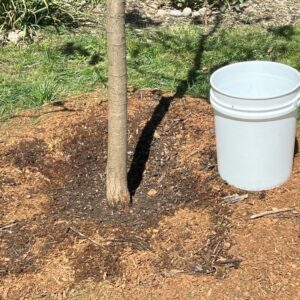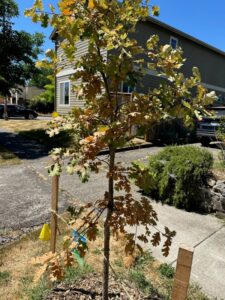Are your trees getting enough water?
Watering tips from the Eugene Team
This July didn’t hesitate to remind us just how hot it can get in an Oregon summer, with five consecutive days with highs over 100° Fahrenheit. And while many of us are lucky to be able to find shelter from a heatwave, trees don’t have that same luxury. For young trees in particular, extreme heat can cause tremendous stress and threaten the trees’ survival.
“It’s around this time every year when we start getting a steady flow of concerns about the well-being of young trees,” says Eugene Director Erik Burke. “Trees can dry out in just a couple days in a heatwave. There are a lot of factors that go into it, including the species and the site conditions.”
Trees that are getting too much water or not enough water can show similar symptoms. Most notably, their leaves will start to brown and curl. In most instances that a tree is getting too much water, it’s because the resident has lawn irrigation systems. It’s more common that a tree is under-watered.
“It can be hard for people to apply enough water,” Erik says. “Sometimes I see people misting the ground beneath their tree with a hose and then walking away. And there wasn’t even enough water to penetrate the soil.”

Trees need deep weekly watering during hot dry summer months: 10 to 15 gallons of water around the base of the tree. It’s important to imagine where the roots are. You want the water to be reaching through the soil to the ends of those roots. It’s also good practice to water in the morning or the evening when you’ll lose less moisture to evaporation. A thick layer of mulch will help retain moisture in the soil.
During a heatwave, your tree might need to be watered more often than once a week, but how do you know if it’s time to water? You can test the soil! There are inexpensive soil moisture readers available at hardware stores, or you can use something you have readily on hand, like a pencil or a stick.
“It’s like testing a cake to see if it’s done,” says. Taylor Glass, our Eugene Springfield Program Manager. Insert your pencil several inches into the soil. When you pull it back up, if soil has stuck to the pencil then it still has moisture and you don’t need to water just yet. If it comes up dry you can go ahead and water your trees. Different soil types will dry out faster than others, so it’s important to check regularly and get to know your tree’s particular site.
“Some trees will suddenly torch, that is, get really dry and stressed,” Erik says. “As soon as you see that, you just want to water the heck out of it. Every species has a different tipping point.”
Some species like the Oregon ash or California buckeye will call it quits for the year when the soil gets dried out in August and just drop their leaves. When they come back next year they’re totally fine. But other trees won’t survive.
To help new tree owners take care of their trees, Friends of Trees sends out volunteer summer inspectors. For the first three summers of a tree’s life it will get two visits. The inspector will check on the tree’s well-being, look for any issues or concerns, and check the soil to see if there’s enough moisture.
“It’s a really fun role,” Taylor says.” You get to learn about trees while walking or biking around your neighborhood.”
With heat waves becoming more and more common, we need trees and the shade they provide to keep us cool. We need to return the favor and make sure we take care of trees so that they can survive and thrive.

